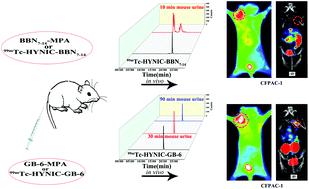当前位置:
X-MOL 学术
›
Biomater. Sci.
›
论文详情
Our official English website, www.x-mol.net, welcomes your feedback! (Note: you will need to create a separate account there.)
A novel peptide targeting gastrin releasing peptide receptor for pancreatic neoplasm detection.
Biomaterials Science ( IF 6.6 ) Pub Date : 2020-05-06 , DOI: 10.1039/d0bm00162g Yuanbiao Tu 1 , Ji Tao 1 , Fang Wang 1 , Peifei Liu 1 , Zhihao Han 1 , Zhaolun Li 1 , Yi Ma 1 , Yueqing Gu 1
Biomaterials Science ( IF 6.6 ) Pub Date : 2020-05-06 , DOI: 10.1039/d0bm00162g Yuanbiao Tu 1 , Ji Tao 1 , Fang Wang 1 , Peifei Liu 1 , Zhihao Han 1 , Zhaolun Li 1 , Yi Ma 1 , Yueqing Gu 1
Affiliation

|
Pancreatic cancer has a high mortality rate and efforts towards diagnosis and therapy at an early stage are particularly appealing. Recently, a small peptide, BBN7-14, has attracted much attention for its specific binding ability to gastrin releasing peptide receptor (GRPR), which is highly overexpressed in various types of cancer, including pancreatic cancer. However, its poor stability in vivo restricts its direct clinical application. Herein, by rational design and transformation of BBN7-14, a novel six-amino acid peptide, GB-6, which maintains a specific GRPR-binding feature and exhibits enhanced stability in vitro and in vivo, was designed. Competitive binding with BBN7-14 and cellular uptake related to GRPR expression levels verified the specific affinity of GB-6 to GRPR. Additionally, this novel peptide was conjugated with near-infrared dye and the radionuclide 99mTc for pancreatic cancer diagnosis in cells and in vivo. Surprisingly, despite having the same cellular affinity as BBN7-14, GB-6 showed much higher pancreatic cancer-targeting ability than BBN7-14 by both fluorescence imaging and radionuclide imaging. It was proven that this strange phenomenon was attributed to the distinct in vivo stability of GB-6 and its more favorable pharmacokinetic properties and metabolic stability relative to BBN7-14. Altogether, this novel peptide GB-6, with GRPR-targeting ability and enhanced stability, is a more promising candidate for the clinical diagnosis of pancreatic cancer.
中文翻译:

靶向胃泌素释放肽受体的新型肽,用于胰腺肿瘤检测。
胰腺癌死亡率高,在早期进行诊断和治疗的努力尤其有吸引力。最近,一种小肽BBN7-14由于其与胃泌素释放肽受体(GRPR)的特异性结合能力而备受关注,而胃泌素释放肽受体在各种类型的癌症(包括胰腺癌)中高度表达。但是,其体内稳定性差,限制了其直接临床应用。在此,通过BBN7-14的合理设计和转化,设计了一种新型的六氨基酸肽GB-6,其保持特定的GRPR结合特征并在体内和体外表现出增强的稳定性。与BBN7-14的竞争结合以及与GRPR表达水平相关的细胞摄取证明了GB-6对GRPR的特异性亲和力。另外,将该新型肽与近红外染料和放射性核素99mTc偶联,可在细胞和体内诊断胰腺癌。令人惊讶的是,尽管具有与BBN7-14相同的细胞亲和力,但GB-6通过荧光成像和放射性核素成像均显示出比BBN7-14更高的胰腺癌靶向能力。事实证明,这种奇怪现象归因于GB-6的独特的体内稳定性以及相对于BBN7-14更有利的药代动力学特性和代谢稳定性。总的来说,具有GRPR靶向能力和增强的稳定性的这种新型肽GB-6是胰腺癌临床诊断的更有希望的候选者。通过荧光成像和放射性核素成像,GB-6显示出比BBN7-14高得多的胰腺癌靶向能力。事实证明,这种奇怪现象归因于GB-6的独特的体内稳定性以及相对于BBN7-14更有利的药代动力学特性和代谢稳定性。总之,具有GRPR靶向能力和增强的稳定性的这种新型肽GB-6是胰腺癌临床诊断的更有希望的候选者。通过荧光成像和放射性核素成像,GB-6显示出比BBN7-14高得多的胰腺癌靶向能力。事实证明,这种奇怪现象归因于GB-6的独特的体内稳定性以及相对于BBN7-14更有利的药代动力学特性和代谢稳定性。总之,具有GRPR靶向能力和增强的稳定性的这种新型肽GB-6是胰腺癌临床诊断的更有希望的候选者。
更新日期:2020-04-08
中文翻译:

靶向胃泌素释放肽受体的新型肽,用于胰腺肿瘤检测。
胰腺癌死亡率高,在早期进行诊断和治疗的努力尤其有吸引力。最近,一种小肽BBN7-14由于其与胃泌素释放肽受体(GRPR)的特异性结合能力而备受关注,而胃泌素释放肽受体在各种类型的癌症(包括胰腺癌)中高度表达。但是,其体内稳定性差,限制了其直接临床应用。在此,通过BBN7-14的合理设计和转化,设计了一种新型的六氨基酸肽GB-6,其保持特定的GRPR结合特征并在体内和体外表现出增强的稳定性。与BBN7-14的竞争结合以及与GRPR表达水平相关的细胞摄取证明了GB-6对GRPR的特异性亲和力。另外,将该新型肽与近红外染料和放射性核素99mTc偶联,可在细胞和体内诊断胰腺癌。令人惊讶的是,尽管具有与BBN7-14相同的细胞亲和力,但GB-6通过荧光成像和放射性核素成像均显示出比BBN7-14更高的胰腺癌靶向能力。事实证明,这种奇怪现象归因于GB-6的独特的体内稳定性以及相对于BBN7-14更有利的药代动力学特性和代谢稳定性。总的来说,具有GRPR靶向能力和增强的稳定性的这种新型肽GB-6是胰腺癌临床诊断的更有希望的候选者。通过荧光成像和放射性核素成像,GB-6显示出比BBN7-14高得多的胰腺癌靶向能力。事实证明,这种奇怪现象归因于GB-6的独特的体内稳定性以及相对于BBN7-14更有利的药代动力学特性和代谢稳定性。总之,具有GRPR靶向能力和增强的稳定性的这种新型肽GB-6是胰腺癌临床诊断的更有希望的候选者。通过荧光成像和放射性核素成像,GB-6显示出比BBN7-14高得多的胰腺癌靶向能力。事实证明,这种奇怪现象归因于GB-6的独特的体内稳定性以及相对于BBN7-14更有利的药代动力学特性和代谢稳定性。总之,具有GRPR靶向能力和增强的稳定性的这种新型肽GB-6是胰腺癌临床诊断的更有希望的候选者。



























 京公网安备 11010802027423号
京公网安备 11010802027423号